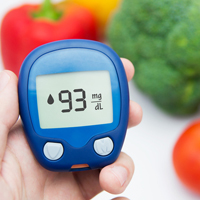Preventing stroke
A stroke happens when a blood vessel bursts in the brain (hemorrhagic stroke), or when blood flow to the brain is blocked or restricted (ischemic stroke). A stroke interrupts the flow of oxygen and nutrients to the brain. When this happens, brain cells start to die within minutes. Because the brain controls body functions, a stroke can cause disability or death.
Some factors that make a person more likely to have a stroke are beyond his or her control, but other risk factors can be controlled.
To reduce the risk of stroke, learn how to manage:
Blood pressure
 High blood pressure, also known as hypertension, is the leading cause of stroke. The National Stroke Association identifies a blood pressure reading of 120 to 139 for the first number or 80 to 89 for the second number as pre-hypertension. People with pre-hypertension are likely to develop high blood pressure.
High blood pressure, also known as hypertension, is the leading cause of stroke. The National Stroke Association identifies a blood pressure reading of 120 to 139 for the first number or 80 to 89 for the second number as pre-hypertension. People with pre-hypertension are likely to develop high blood pressure.
Some ways to reduce high blood pressure include:
- Maintaining proper weight.
- Avoiding drugs known to raise blood pressure.
- Eating well.
- Exercising more.
- Taking medication that helps reduce blood pressure.
Diet
 A diet that helps lower the risk of stroke is low in saturated and trans fats; rich in potassium, calcium, magnesium, fiber and protein; and lower in sodium.
A diet that helps lower the risk of stroke is low in saturated and trans fats; rich in potassium, calcium, magnesium, fiber and protein; and lower in sodium.
The DASH diet (short for Dietary Approaches to Stop Hypertension), based on research sponsored by the U.S. National Institutes of Health, is designed to help people lower their blood pressure, which reduces the risk of stroke.
DASH emphasizes fruits, vegetables, whole grains, poultry and fish, and it recommends limiting red meat, sweets and sugary beverages.
Many resources and recipes are available to help those who choose the follow the DASH diet.
Physical activity
 People who are fit and strong are far less likely to suffer from stroke.
People who are fit and strong are far less likely to suffer from stroke.
The surgeon general recommends that adults get 2½ hours of moderate-intensity aerobic exercise each week through such activities as running, walking briskly, playing basketball, dancing or swimming. Exercise for good health »
Blood sugar
 Diabetes weakens arteries and veins, including the blood vessels in the brain. This happens because the diabetic has too much glucose in his or her blood. The excess glucose can build up on the walls of the blood vessels or cause blood clots, restricting or shutting off blood flow.
Diabetes weakens arteries and veins, including the blood vessels in the brain. This happens because the diabetic has too much glucose in his or her blood. The excess glucose can build up on the walls of the blood vessels or cause blood clots, restricting or shutting off blood flow.
Losing weight and keeping it off; improving eating habits; and exercising are all keys to reducing blood sugar and controlling diabetes. Those who already have diabetes should consult a health professional to develop a strategy for controlling it.
Weight
 Carrying extra weight makes the heart work harder to pump blood through the body, straining the entire circulatory system. Obesity is linked with stroke, as well as heart disease and high blood pressure.
Carrying extra weight makes the heart work harder to pump blood through the body, straining the entire circulatory system. Obesity is linked with stroke, as well as heart disease and high blood pressure.
The National Heart, Lung and Blood Institute recommends measuring a person’s risk of health-related diseases by using two measurements: body mass index and weight circumference (belly fat).
Often, losing even 5 to 10 pounds can make a significant difference in health, including stroke risk.
Smoking
 Cigarette smoking doubles the risk of stroke when compared to a nonsmoker, because it increases the formation of blood clots, thickens the blood, and increases plaque buildup in the arteries, according to the National Stroke Association.
Cigarette smoking doubles the risk of stroke when compared to a nonsmoker, because it increases the formation of blood clots, thickens the blood, and increases plaque buildup in the arteries, according to the National Stroke Association.
The National Institute of Neurological Disorders and Stroke points out that studies show smoking increases the likelihood of blockage of the carotid artery, a main supplier of blood to the brain.
Quitting smoking immediately, no matter how long you have been smoking, can significantly reduce the risk of stroke. Learn more about quitting »
Learn more about preventing stroke
Health Benefits of Quitting Smoking »
How to Reduce High Blood Pressure »
Resources
National Stroke Association –1-800-787-6537
American Stroke Association – 1-888-478-7653
